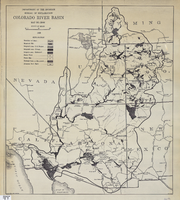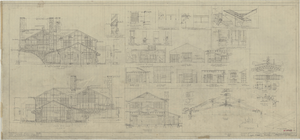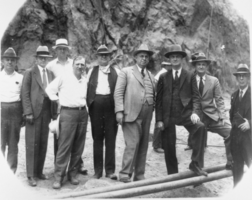Search the Special Collections and Archives Portal
Search Results

Map of Colorado River Basin, 1928
Date
Description
Image
Erma Linda Rivera oral history interview
Identifier
Abstract
Oral history interview with Erma Linda Rivera conducted by Laurents Bañuelos-Benitez, Nathalie Martinez, Maribel Estrada Calderón, and Barbara Tabach on January 09, 2019 for the Latinx Voices of Southern Nevada Oral History Project. In this interview, Erma Linda Rivera discusses her early life as a grandchild of immigrants. She shares her experiences growing up in a mining town in Arizona. After marrying, both Erma Linda and her husband Jose became federal civil servants. This would lead Erma Linda Rivera to Las Vegas, Nevada in 1984. Prior to retirement, Rivera worked as an regional Equal Employment Opportunity manager. Rivera discusses her career working for the Department of the Interior, sharing how her job helped fuel her passion for social justice. Erma Linda relates the importance of civic involvement in her life. Finally, she reflects on how Henderson, Nevada has changed over the years she has lived there.
Archival Collection
Kent Carmichael oral history interview
Identifier
Abstract
Oral history interview with Kent Carmichael conducted by Stefani Evans on November 25 and December 2, 2019 for the Boyer Early Las Vegas Oral History Project.
In the first session of this oral history, Carmichael discusses his early career in lighting design and maintenance from his start at Interstate Neon to his work in the 1950s and 60s in Las Vegas. He discusses some of the iconic signs he built including the Casino Center, Carnival Room, Thunderbird, The Frontier, Bonanza, and the Stardust. He also details the technology and inner workings of these innovative signs including the transition from mechanical to electrically controlled signage. Carmichael continues to discuss Native American laborers and various individuals that he interacted with throughout his early career including Max and Mo Oggenblick, Doby Doc, Benny Binion, Arby Alper, Steve Wynn, Peter Arp, and Wayne and Jerry Newton. Carmichael ends the first interview by recalling a high wind event that damaged the Frontier sign and his efforts to bring the sign under control and repair it as well as his vision and behind the Stardust sign.
The second oral history interview contains Carmichael’s discussion of his career from 1968 onward. He immediately picks up discussion of the Stardust sign and his transition to desk work. Carmichael details the challenge and limitations of designing the International sign (the Westgate as of 2021). He describes the development of his first messenger sign for the International and the time consuming task of using tape to program the sign. He fondly remembers working on the Holiday Inn Riverboat signs, and International transition to Las Vegas Hilton and the Hilton’s transition from blue to red letters. Carmichael shares the story of being caught between organized crime and a young Steve Wynn. He recounts his last project for Ad Art, developing and construction the sign for the Louisiana Superdome in New Orleans, Louisiana. He details working through legislative and construction issues as well as the fallout from the Nat Kiefer Commission.
After leaving Ad Art Carmichael began working with Heath and Co. and began collaborating with Raul Rodriguez. Carmichael and Rodriguez went on to design some of the most enduring and visually unique signs in Las Vegas including, the Flamingo, Four Queens, Golden Nugget, Dunes Hotel, and the Desert Inn. They also worked in Reno on Circus Circus and El Dorado. Carmichael also details his interior work including the main pylon and interior signs for MGM Grand; 1974 renovation Golden Nugget, suspended stained glass ceiling at Tropicana, and the MGM Lion display. Lastly Carmichael outlined his work with Young Electric Sign 1983-85 and the Dewey Sign Company including the Las Vegas Convention Center sign. He ends by sharing his views on the role and importance of lighting in Las Vegas.
Archival Collection
Stardust Resort and Casino Photograph Collection
Identifier
Abstract
The Stardust Resort and Casino Photograph Collection, approximately 1970 to 1979, consists of black-and-white and color photographic prints of the Stardust Hotel and Casino in Las Vegas, Nevada. The photographs depict the interior and exterior of the hotel before and after its renovation in 1975.
Archival Collection
"Party reel" for unknown Stardust event: video, 2004 January 28
Level of Description
Scope and Contents
Promotional video created by Laguna Productions for Boyd Gaming Corporation. The video features all the Boyd properties, including Las Vegas, Henderson, the midwest, and Atlantic City. Don Snyder, President, speaks on the company's mission and goals to take care of each and every guest. The video then details individual properties, showing interior and exterior clips of all the locations. Starting with the Eldorado Casino and Jokers Wild casinos, aimed at serving the local population. The video speaks to the games available at each location, dining options, and convenient location on the way to Lake Mead recreation. The next casino is Sam's Town, the California Hotel and Casino, Main Street, and the Fremont. Each location has particular qualities and amenities that are highlighted by the voiceover, as well as the historical information about when it was purchased by Boyd. The Stardust Resort and Casino is the last Las Vegas location highlighted. Additional hotel/casinos and racetracks featured are: Sam's Town Tunica (Mississippi), Treasure Chest (New Orleans), Par-a-dice (Illinois), Blue Chip (Lake Michigan, Indiana), Delta Downs (Louisiana), and Borgata (Atlantic City). Original media Betacam SP, color, aspect ratio 4 x 3, frame size 720 x 486.
Archival Collection
Collection Name: Stardust Resort and Casino Records
Box/Folder: Digital File 00, Box 049
Archival Component

Delta Saloon in Virginia City, Nevada: postcard
Date
Archival Collection
Description
Image

Architectural drawing of addition to pavilion at Zion National Park, Utah, elevations, sections and details, December 12, 1925
Date
Description
Additions to pavilion building, Zion National Park, Utah. North and south exterior elevations, various interior elevations, numerous details, sections, plans and loading and stress diagrams for additions to the pavilion building at Zion National Park, Utah. Scales as shown. "Dr. by D.A.E., R.R.C., W.L.H. " "#15782-F. Sheet no. 6. Job no. 348. Date: 12/12/25." "Recommended by D.R. Hull per T.C. Unit, Landscape Eng. N.P.S. Approved by Stephen T. Mather, Director, N.P.S." "Rev. 1/11/26, 2/2/26, 3/2/26."
Site Name: Zion National Park (Utah)
Image
The Jewelers at MGM Grand Las Vegas, 2016
Level of Description
Archival Collection
Collection Name: American Institute of Architects (AIA) Nevada Design & Service Awards Records
Box/Folder: Digital File 00
Archival Component
Navajo composed by Van Alystyne, Egbert: sheet music, 1903
Level of Description
Archival Collection
Collection Name: Bob Stoldal Collection of Nevada Sheet Music
Box/Folder: Box 03
Archival Component

Film transparency of businessmen, politicians, and engineers at Hoover Dam, June 6, 1933
Date
Archival Collection
Description
Image
